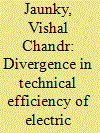| Srl | Item |
| 1 |
ID:
103381


|
|
|
|
|
| Publication |
2011.
|
| Summary/Abstract |
The paper attempts to test the Environment Kuznets Curve (EKC) hypothesis for 36 high-income countries for the period 1980-2005. The test is based on the suggestion of Narayan and Narayan (2010). Various panel data unit root and co-integration tests are applied. Carbon dioxide (CO2) emissions and GDP series are integrated of order one and co-integrated, especially after controlling for cross-sectional dependence. Additionally, the Blundell-Bond system generalised methods of moments (GMM) is employed to conduct a panel causality test in a vector error-correction mechanism (VECM) setting. Unidirectional causality running from real per capita GDP to per capita CO2 emissions is uncovered in both the short-run and the long-run. The empirical analysis based on individual countries provides evidence of an EKC for Greece, Malta, Oman, Portugal and the United Kingdom. However, it can be observed that for the whole panel, a 1% increase in GDP generates an increase of 0.68% in CO2 emissions in the short-run and 0.22% in the long-run. The lower long-run income elasticity does not provide evidence of an EKC, but does indicate that, over time, CO2 emissions are stabilising in the rich countries.
|
|
|
|
|
|
|
|
|
|
|
|
|
|
|
|
| 2 |
ID:
125733


|
|
|
|
|
| Publication |
2013.
|
| Summary/Abstract |
This paper investigates the convergence pattern of technical efficiency of the South Africa Power Pool (SAPP) utilities over the period April 2003-March 2010 by means of parametric and non-parametric techniques. Technical efficiency scores are computed via both stochastic frontier analysis and data envelopment analysis. Mixed results are obtained from the neoclassical convergence approaches. In addition, distribution dynamics methods reveal some evidence of club-formation and this result is supported with the occurrence of ?-divergence. Taken as a whole, technical efficiency is found to diverge among the utilities operating in the power pool.
|
|
|
|
|
|
|
|
|
|
|
|
|
|
|
|